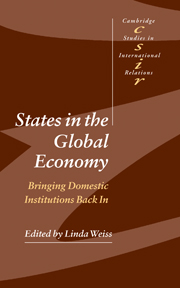Book contents
- Frontmatter
- Contents
- List of figures
- List of tables
- List of contributors
- Preface
- 1 Introduction: bringing domestic institutions back in
- Part I The resilience of welfare states
- Part II New economic challenges, changing state capacities
- 5 France: a new ‘capitalism of voice’?
- 6 The challenges of economic upgrading in liberalising Thailand
- 7 Building institutional capacity for China's new economic opening
- 8 New regimes, new capacities: the politics of telecommunications nationalisation and liberalisation
- 9 Ideas, institutions, and interests in the shaping of telecommunications reform: Japan and the US
- 10 Diverse paths towards ‘the right institutions’: law, the state, and economic reform in East Asia
- Part III Governing globalisation
- List of references
- Index
- CAMBRIDGE STUDIES IN INTERNATIONAL RELATIONS
7 - Building institutional capacity for China's new economic opening
Published online by Cambridge University Press: 22 September 2009
- Frontmatter
- Contents
- List of figures
- List of tables
- List of contributors
- Preface
- 1 Introduction: bringing domestic institutions back in
- Part I The resilience of welfare states
- Part II New economic challenges, changing state capacities
- 5 France: a new ‘capitalism of voice’?
- 6 The challenges of economic upgrading in liberalising Thailand
- 7 Building institutional capacity for China's new economic opening
- 8 New regimes, new capacities: the politics of telecommunications nationalisation and liberalisation
- 9 Ideas, institutions, and interests in the shaping of telecommunications reform: Japan and the US
- 10 Diverse paths towards ‘the right institutions’: law, the state, and economic reform in East Asia
- Part III Governing globalisation
- List of references
- Index
- CAMBRIDGE STUDIES IN INTERNATIONAL RELATIONS
Summary
Introduction: is China a neoliberal state in the making?
Few people would deny that China's economic miracle is consistent with its continuing integration into the world economy. According to a survey in The Economist (Ziegler 2000: 20), economic growth in China averaged nearly 8 per cent a year from 1979, and exports grew by 15 per cent and imports by 13 per cent a year between 1979 and 1999 – ‘a faster rate of growth than Japan managed during its golden period in 1953–73’. China became the tenth biggest exporter in the world in the mid-1990s, and the amount of foreign direct investment (FDI) it has received in recent years is exceeded only by that of the United States. Nicholas Lardy (1994: 110), a US expert on China's foreign economic relations, notes that in many respects, ‘China is already somewhat more integrated into the world economy than Japan, Taiwan, or South Korea were at comparable stages of their economic development’. As China has just entered the World Trade Organisation (WTO), the Chinese economy is set to become even more integrated into the world market.
Given China's two-decade experience of rapid growth and increasing openness, it seems a good test case for the main theme of this book: the role of domestic institutions in an era of intensifying economic interdependence. Thomas Moore (1996) argues that there is a ‘global’ logic behind China's economic opening.
- Type
- Chapter
- Information
- States in the Global EconomyBringing Domestic Institutions Back In, pp. 142 - 160Publisher: Cambridge University PressPrint publication year: 2003
- 9
- Cited by

